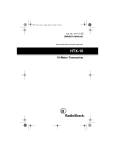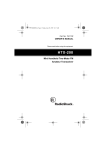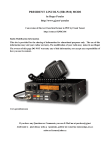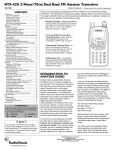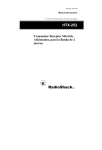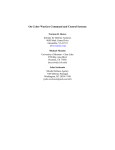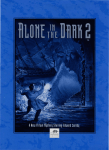Download PRESIDENT HR2510 Specifications
Transcript
PRESIDENT HR2600 10 Meter Amateur Mobile Transceiver Doc’s Electronics http://hr2510.homeip.net:2510/ Doc’s Electronics http://hr2510.homeip.net:2510/ Contents Welcome! . . . . . . . . . . . . . . . . . . . . . . . . . . . . . . . . . . . . . . . . .2 Unpacking . . . . . . . . . . . . . . . . . . . . . . . . . . . . . . . . . . . . . .2 Controls and Functions . . . . . . . . . . . . . . . . . . . . . . . . . . . 3-5 Front Panel Connector . . . . . . . . . . . . . . . . . . . . . . . . . . . . . 6 CTCSS Control . . . . . . . . . . . . . . . . . . . . . . . . . . . . . . . . . . . 7 Setting & Using CTCSS . . . . . . . . . . . . . . . . . . . . . . . . . . .7 Switch Settings for S301 . . . . . . . . . . . . . . . . . . . . . . . . . . .8 Rear Panel Connectors . . . . . . . . . . . . . . . . . . . . . . . . . . . . . 9 Power Connector . . . . . . . . . . . . . . . . . . . . . . . . . . . . . . . 9 Antenna Connector . . . . . . . . . . . . . . . . . . . . . . . . . . . . . 10 Installation . . . . . . . . . . . . . . . . . . . . . . . . . . . . . . . . . . . . . 11 Transceiver Mounting . . . . . . . . . . . . . . . . . . . . . . . . . . . 11 Mobile Antenna . . . . . . . . . . . . . . . . . . . . . . . . . . . . . . . . 11 Ground Information . . . . . . . . . . . . . . . . . . . . . . . . . . . . 11 Power Cord Connection . . . . . . . . . . . . . . . . . . . . . . . . . 11 Operation . . . . . . . . . . . . . . . . . . . . . . . . . . . . . . . . . . . . . . 12 Selecting a Frequency . . . . . . . . . . . . . . . . . . . . . . . . . . .12 VFO Operation . . . . . . . . . . . . . . . . . . . . . . . . . . . . . . . . 12 Repeater Operation . . . . . . . . . . . . . . . . . . . . . . . . . . . . . 12 USB/LSB/AM/FM Operation . . . . . . . . . . . . . . . . . . . . . 12 Noise Blanker . . . . . . . . . . . . . . . . . . . . . . . . . . . . . . . . . 12 F. Lock . . . . . . . . . . . . . . . . . . . . . . . . . . . . . . . . . . . . . . 12 CW Operation . . . . . . . . . . . . . . . . . . . . . . . . . . . . . . . . . 13 Receive Scanning . . . . . . . . . . . . . . . . . . . . . . . . . . . . . . 13 Scanning Operation . . . . . . . . . . . . . . . . . . . . . . . . . . . . . 13 Multifunction Meter . . . . . . . . . . . . . . . . . . . . . . . . . . . . 14 S/RF Meter . . . . . . . . . . . . . . . . . . . . . . . . . . . . . . . . . . . 14 MOD Meter . . . . . . . . . . . . . . . . . . . . . . . . . . . . . . . . . . 14 SWR CAL Meter . . . . . . . . . . . . . . . . . . . . . . . . . . . . . . 14 SWR Meter . . . . . . . . . . . . . . . . . . . . . . . . . . . . . . . . . . . 15 Specifications . . . . . . . . . . . . . . . . . . . . . . . . . . . . . . . . . . . 16 General . . . . . . . . . . . . . . . . . . . . . . . . . . . . . . . . . . . . . . 16 Transmitter . . . . . . . . . . . . . . . . . . . . . . . . . . . . . . . . . . . 16 Receiver . . . . . . . . . . . . . . . . . . . . . . . . . . . . . . . . . . . . . 16 Troubleshooting . . . . . . . . . . . . . . . . . . . . . . . . . . . . . . . . . 17 Amateur Radio Operation . . . . . . . . . . . . . . . . . . . . . . 18-19 One Year Limited Warranty WARRANTOR: UNIDEN CORPORATION OF AMERICA (“UNIDEN”.) ELEMENTS OF WARRANTY: UNIDEN warrants, for the duration of this warranty, UNIDEN CB Product (hereinafter referred to as the Product) to be free from defects in materials and craftsmanship with only the limitations or exclusions set out below. WARRANTY DURATION: This warranty shall terminate and be of no further effect one (1) year after the date of the original purchase of the Product or at the time the Product is (A) damaged or not maintained as reasonable or necessary, (B) modified, (C) improperly installed, (D) repaired by someone other than warrantor for a defect or malfunction covered by this warranty, (E) used in a manner or purpose for which the Product was not intended, or (F) sold by the original purchaser. STATEMENT OF REMEDY: In the event that the product does not conform to this warranty at any time while this warranty is in effect, warrantor will repair the defect and return it to you without charge for parts, service, or any other cost incurred by warrantor or its representatives in connection with the performance of this warranty. THIS WARRANTY DOES NOT COVER OR PROVIDE FOR THE REIMBURSEMENT OF PAYMENT OF INCIDENTAL OR CONSEQUENTIAL DAMAGES. Some states do not allow this exclusion or limitation of incidental or consequential damages so the above limitation or exclusion may not apply to you. WARRANTY REGISTRATION CARD: In order to facilitate the servicing of this warranty by warrantor, the Warranty Registration Card should be returned to the warrantor. However, return of the Warranty Registration Card is not a precondition of this warranty, and this warranty will be observed by the warrantor whether or not the Warranty Registration Card is returned, provided that other satisfactory evidence of the date of purchase is provided. PROCEDURE FOR OBTAINING PERFORMANCE OF WARRANTY: In the event that the Product does not conform to this warranty, the Product should be shipped or delivered, freight prepaid, with evidence of original purchase, to warrantor at: UNIDEN CUSTOMER SERVICE CENTER 9900 Westpoint Drive Indianapolis, IN 46250 LEGAL REMEDIES: This warranty gives you specific legal rights, and you may also have other rights which vary from state to state. This warranty is void outside of the United States of America. Warranty . . . . . . . . . . . . . . . . . . . . . . . . . . . . . . . . . . . . . . 20 Doc’s Electronics http://hr2510.homeip.net:2510/ Doc’s Electronics http://hr2510.homeip.net:2510/ Welcome! NOTES/MEMOS To the world of 10 Meter amateur radio communications! You have purchased what we feel to be the finest 10 Meter mobile transceiver available. Your HR 2600 has been designed using the latest state of the art electronics to give you years of trouble free service. To get the most from your HR 2600, please read this operating guide thoroughly. WARNING: To operate this transceiver, you MUST have an FCC Radio Amateur Operator’s license. Operation of this device without a license is ILLEGAL and carries heavy penalties. Unpacking Your HR 2600 is supplied with the following items. If any items are missing or appear damaged, DO NOT return the unit to the place of purchase. Instead, contact Uniden Customer Service at (317) 842-2483, 8 am-5 pm EST, Monday through Friday. HR 2600 10 Meter Transceiver Dynamic Microphone with Channel Up/Down control Transceiver & Microphone Mounting Brackets & Hardware Power Cord with In-Line fuse holder Accessory Plug (Jumpered for internal speaker use) Accessory Plug (With wires for connecting accessories) This operating guide We also recommend that you retain the original box and packing, as it makes a convenient way to transport the unit. Doc’s Electronics http://hr2510.homeip.net:2510/ Doc’s Electronics http://hr2510.homeip.net:2510/ Controls and Functions 1. Mode Switch - This control is used to select the desired transmit mode. The modes available are: CW, LSB, USB, AM, and FM. 2. SWR/CAL Control - This control is used to adjust the calibration of the SWR meter while in SWR CAL mode. 3. RIT Control - The Receiver Incremental Tuning control is used to fine tune the received signal. This is used in USB and LSB modes to obtain maximum clarity of reception, and in CW mode to control the pitch of the beat note. The RIT control can tune the receive frequency about ± 3 kHz. This control will not affect the transmit frequency, or the frequency display, but will change the receive frequency 4. RIT Switch - This switch enables or disables the RIT control. Press to enable (button down). Press again to disable (button up). 5. RF Gain Control - This is used to vary the RF input to the receiver. This control is used to help eliminate strong, adjacent signals 6. Mic Gain Switch - Pressing this switch activates the built-in microphone attenuator. This feature is designed to be used when operating the HR 2600 in high ambient noise environments 7. TX Switch - The TX switch is used to lock the transmitter on for tuning purposes, except in CW mode. In CW mode the external key must be locked down. The microphone is disconnected unless the PTT switch is also depressed 8. Meter Switch - This switch is used to select the operating mode for the multifunction meter. The meter modes are: S/RF, Modulation, SWR Calibration setting, and SWR. Each time the Meter switch is pushed, the next mode is selected. See the operation section for more information on meter usage. The currently selected mode is displayed above the meter. 9. NB Switch - Pressing this switch enables the built in noise blanker. The noise blanker in your HR 2600 is very effective in eliminating interference generated by, vehicle ignition systems. Doc’s Electronics http://hr2510.homeip.net:2510/ NOTES/MEMOS Doc’s Electronics http://hr2510.homeip.net:2510/ Amateur Radio Operation - continued Eventually, you’ll probably want to get another, higher class of amateur license, with more privileges. Exams for Technician, General, Advanced, and Extra Class licenses are given by three-member Volunteer Examiner Teams. Hundreds of exam sessions are held across the country every month, most on weekends. (You can take the Novice exam from a Volunteer Examiner Team, too, if it’s more convenient.) When you’re ready, you can get a schedule of exam opportunities in your area from the ARRL We’ve mentioned the ARRL several times. That’s because the League is the national organization that represents Amateur Radio in the United States. The League has more than 150,000 members; most of them hams, but including lots of hams-to-be. Here’s the address of ARRL Headquarters The American Radio Relay League 225 Main Street Newington CT 06111 The ARRL staff helped us prepare this section of the operating guide, and they would be glad to hear from you if you need more information, or if you’d like to join! Doc’s Electronics http://hr2510.homeip.net:2510/ Controls and Functions - continued 10. Dim Switch - Pressing the Dim switch dims the display backlighting. Press again to return backlighting to its normal (high) level. 11. Scan Switch - The Scan control is used to scan up to 100 frequencies in each band segment. See the section on operation for more information on using the Scan Control. 12. Span (Step Size) Switch - This control is used to select either 10 kHz, 1 KHz, or 100 Hz steps for the VFO. The currently selected step is indicated by a line under the relevant digit on the Frequency Display. 13. A and V - Pressing these controls will step up or down in frequency by the amount of the span control. 14. Band Switch - Pressing this control will select one of the four band segments. Band segments are: a:28.0000 - 28.4999, b:28.5000-28.9999, c:29.0000-29.4999, and d:29.5000-29.6999 MHz. The currently selected band segment is displayed next to the frequency display. 15. F. Lock Switch -Pressing the Frequency Lock button will disable all frequency determining controls on the front panel (except RIT) and on the microphone, to prevent accidental changes of frequency. 16. Digital VFO Control - The Variable Frequency Oscillator control is used to select the desired transmit and receive frequency. Tuning is continuous throughout the entire range of the HR 2600, with no need to select band segments. 17. Squelch Control - The Squelch control is used to adjust the squelch function, which eliminates the “rushing” sound between transmissions. Turning the squelch control CCW until it clicks enables the auto squelch, eliminating the need to manually adjust the squelch. 18. On/Off/Volume Control - This control is used to turn the unit on or off and to adjust the volume. 19. RPT Switch - Pressing this control enables the 100 KHz frequency split for FM repeater operation. When selected, a “P” is displayed above the band segment display. Doc’s Electronics http://hr2510.homeip.net:2510/ Controls and Functions - continued 20. Multifunction Meter - This meter can display S/RF, Modulation, SWR Cal, or SWR. See item (8), Meter Switch and the operation section for more information. 21. Frequency Display - The Frequency Display displays the currently selected transmit and receive frequency. 22. Meter Mode Display - Displays the currently selected meter operating mode. 23. Band Segment Display - Shows the currently selected band segment. 24. Repeat Mode Display Shows a “P” if repeater mode is selected. 25. TX Indicator - Illuminates when PTT or TX Switch is pressed, or CW key is down. 26. VFO Step Indicator - Displays the currently selected VFO step. (The photo shows 100Hz step selected). 27. Remote A and V switches - You can step up or down by the setting of the span control using these controls. See the section on operation for more information. 28. PTT Switch - The Push to Talk switch is used to control the transmit and receive of your HR 2600. Press to transmit, and release to receive. Doc’s Electronics http://hr2510.homeip.net:2510/ Amateur Radio Operation Your new President transceiver is designed to be the perfect “first radio” for anyone entering the exciting world of Amateur Radio. From your home, car, or boat, you will find that it opens a door to the world - literally! All you need is a source of electrical power, a suitable antenna, and most important of all, an Amateur Radio Operator’s License issued by the Federal Communications Commission (FCC). You may already have a license. In fact, you may have been a ham operator for many years. But if you don’t have a license, you’ll find that it’s easy to get one, and there is lots of help available. Here are a few tips to help you get started. First, go ahead and hook up the equipment. Use the receiver section to find out what’s going on. But don’t even think of transmitting until you get your license. That’s very important. Transmitting without a license is a violation of Federal Law that could lead to severe penalties. Also, ham operators take the FCC rules very seriously and want nothing to do with “bootleggers” - their term for people who operate without a license. Second, find out if there’s a ham radio club in your area. There are thousands of them across the country, so there’s probably at least one in or near your own community. The people at the store where you bought your equipment may be able to tell you. If not, and you don’t hear anyone talking about a local club in your area as you tune around the band with your receiver, write to the American Radio Relay League at the address at the end of this section for information on how to contact their local affiliate. Most clubs welcome newcomers, and would be glad to help you obtain your license. Next, start studying for your license. Don’t let the word “study” scare you, because most people can go from knowing absolutely nothing about radio to passing the basic (Novice) class license exam in less than 40 hours of study spread out over several weeks. The test will be on basic radio regulations, a little bit of radio theory, and slow speed Morse Code. Many clubs teach license classes (a fun and easy way to learn about Amateur Radio), and there are good books, cassette tapes, computer programs, and lots of other study aids available. The ARRL publishes a book, Tune in the World with Ham Radio which is usually packaged with two tape cassettes and has all you need to know. But, don’t overlook the products of commercial publishers that you will see in radio and electronics stores. Finally, you’ll be ready to pass the exam. You won’t have to go to an imposing Federal office building in a big city to take the test, because these days, the FCC has ham volunteers give all of the exams. For the Novice license, the examiners can be any two hams with General or higher class licenses who are at least 18 years old and not related to you. And, the Novice exam is free! The Novice class license will let you use your HR 2600 between 28.1 and 28.5 MHz on CW (Morse Code) between 28.1 and 28.5 MHz, and on SSB (voice) between 28.3 and 28.5 MHz. Your HR 2600 has more frequencies and operating modes built in, which you will be able to use once you have a General or higher class license. There’s no rush - your Novice license will be good for ten years, and even then you can renew it indefinitely. Doc’s Electronics http://hr2510.homeip.net:2510/ Troubleshooting Front Panel Connector If your HR 2600 is not performing up to your expectations, please try these simple steps. If you still cannot get satisfactory results after reading this manual and following the troubleshooting steps, please contact Uniden Customer Service at: (317) 842-2483. Trouble Unit will not turn on No Power Check 1. Check power cord and all connections. 2. Check power cord fuse. 3.. Check vehicle electrical system Channel Up 3 4 2 Channel Down 5 Transmit (PTT) 1 4. Check unit grounding. Poor Reception 1. Check & adjust squelch. Microphone Connector 2. Check antenna. 3. Check antenna cable. 4. Check antenna connectors. 5. Check operating mode of radio. Weak Transmission The microphone included with the HR 2600 is a 5005 dynamic microphone, with frequency up and down switches. The view of the connector is facing the HR 2600 front panel. The pin connections are as follows: 1. Check antenna. Pin Connection 1&2 Microphone 3&2 PTT Switch 4. Check operating mode of radio. 4&2 Channel Up Switch 5. Check antenna SWR. 5&2 Channel Down Switch 6. Check antenna grounding. 2 Common Ground 2. Check antenna cable. 3. Check antenna connectors. 7. Check for corrosion on connectors. Doc’s Electronics http://hr2510.homeip.net:2510/ Doc’s Electronics http://hr2510.homeip.net:2510/ CTCSS Control Specifications Setting & Using CTCSS The HR 2600 has a built-in CTCSS encoding (Continuous Tone Coded Squelch System) for accessing repeaters. CTCSS is activated only in FM RPT mode of operation. To set the CTCSS frequency, proceed as follows: 1. Place the unit top down on a non-scratching surface. 2. Remove the cover screws for the bottom half of the case (see photo above). Use caution when removing the bottom half of the case, since the speaker is connected to the main board. Do not pull on the wires. 3. Using the table at the right, set S301 for the desired CTCSS frequency. If no CTCSS tone is desired, place all switches (S301 -1 through S301-6) into either the on or off position. 4. Replace the cover and securely fasten using the screws. Do not overtighten the screws, or damage to the threads may result. 5. To use CTCSS encode mode, place the mode switch into the FM position, and press the RPT switch (down position). You are now ready for CTCSS encoded repeater operation. Note: The CTCSS board in the HR 2600 is encode only. Receiver operation is normal carrier squelch Doc’s Electronics http://hr2510.homeip.net:2510/ Doc’s Electronics http://hr2510.homeip.net:2510/ Operation - continued SWR Meter After you have calibrated the SWR Meter according to the SWR CAL procedure previously shown, you are ready to proceed to check the SWR of your HR 2600 and antenna. Press the Meter button until “SWR” is displayed above the meter (once after completing the SWR CAL procedure). At this point, pressing the PTT switch on the microphone if in AM or FM mode, or pressing the CW key if in CW mode will transmit a signal. As you transmit, your SWR will be displayed on the meter. Warning: Standing Wave Ratios in excess of 2:1 may cause transmitter damage Switch Settings for S301 (H=ON) Doc’s Electronics http://hr2510.homeip.net:2510/ Doc’s Electronics http://hr2510.homeip.net:2510/ Rear Panel Connectors 1 2 3 4 5 6 7 8 9 Accessory Connector Operation - continued Multifunction Meter The Multifunction Meter built in to your HR 2600 provides a number of useful functions. These are: S/RF Meter MOD Meter SWR CAL Meter SWR Meter Every time you press the Meter button, the next function will be selected. When you reach the end of the functions, it will start over with the first. When in receive mode, the meter is always in the “S” function. (Received signal strength.) There are two plugs for the accessory connector included with your HR 2600. One plug contains only a jumper between pins 1 and 7, which is used only to enable the internal speaker. The other plug is wired so that you can conveniently connect accessories to your HR 2600. The view of the connector is facing the rear panel of the unit. The pin connections and wiring color codes are as follows Wire Color Connection 1&2 4&5 8&9 Pin Red/Black Blue/Black Black/Yellow 1&7 Red/White 3&6 n.c. External Speaker N.C. CW Key (Yellow wire (pin 9) is “hot” side (positive) if there is any polarity on the key.) Internal Speaker (Jumper to use internal speaker, open if external speaker is connected.) Power Connector The power cord included with the HR 2600 is color coded. The red wire goes to +13.8 V DC nominal and the black wire goes to ground. The HR 2600 is designed for operation with a negative ground system only. The view of the power connector is facing the rear panel of the HR 2600 Doc’s Electronics http://hr2510.homeip.net:2510/ S/RF Meter The S/RF meter function provides a visual indication of relative received signal strength and relative transmit power. To use the S/RF function, press the Meter button until “RF” is displayed over the meter display. The meter automatically switches function depending on whether you are transmitting (RF Mode) or receiving (S mode). MOD Meter This function gives you an indication of the strength of your modulation when transmitting. There is no function for this meter when receiving signals. To use the MOD function, press the Meter button until “MOD” is displayed over the meter display. SWR CAL Meter Note: The SWR CAL and SWR functions are not operative in USB and LSB modes. You must select either AM, FM, or CW modes for calibrating and checking SWR. This mode of the multifunction meter is used to calibrate the meter for the SWR function. To use this mode, press the Meter button until the small triangle is visible under the meter, near the right side. No other meter mode indications will be visible at the same time. Press the PTT switch on the microphone or the TX button in AM or FM modes, or hold down the CW key in CW mode, and adjust the meter so that it indicates to the triangle. Use the SWR CAL control for the adjustment. When you have done this, you are ready to check the SWR. Note: Don’t forget that all transmissions must be properly identified, and remember to listen on the frequency before transmitting. Doc’s Electronics http://hr2510.homeip.net:2510/ Operation - continued Rear Panel Connectors - continued CW Operation Using CW mode with the HR 2600 is easy. Just select your operating frequency, place the mode switch in CW, and you’re ready to transmit CW if you have connected an external key to the accessory plug on the rear of the unit. (See the section on rear panel connectors for information on connecting a CW key.) To use CW mode with an external key, select an operating frequency, place the mode switch in CW, and you are now ready to operate as semi break-in CW mode. (If you leave the key up for more than .5 second, the receiver is enabled. The HR 2600 has a built-in sidetone oscillator for your convenience. Note: If the TX switch is depressed, the receiver will be disabled. The HR 2600 will NOT transmit in CW mode unless an external key is connected and in a key down condition. To adjust the pitch of the received CW note, you can use either the VFO or RIT to tune it as desired. If you initiated transmission, use the RIT control to adjust the pitch. If you are answering a call, use the VFO to adjust the pitch to about 800 Hz to zero-beat the signal with the RIT off. (Note: Adjusting the RIT will NOT affect the frequency display) Receive Scanning The receive scanning functions of your HR 2600 make it easy to find active frequencies. You can scan 100 5 KHz channels in segment a,b,or c, and 40 channels in segment d. Scanning is always from the lower frequency to higher frequencies, and always in 5 KHz steps. Scanning Operation To begin scanning, press the Scan button. If there is a transmission on the current frequency (the squelch is broken open), pressing the Scan button will just step up 5 KHz. If the squelch is NOT broken, scanning will begin. The unit will scan through the selected band segment until it encounters a signal strong enough to break (open) the squelch. It will then stop on that frequency for the duration of the transmission. When the transmission stops, the HR 2600 will wait approximately 1.5 seconds before resuming the scan cycle, to allow you to hear a return transmission on that frequency. If you take no further action, the scan will resume. When the scan has stopped for a transmission, momentarily pressing the A or V switch on the microphone will stop the scan on the frequency. To exit from scan mode while still scanning, simply press either the A or V button on the microphone or front panel, or Scan, F. Lock, or Band. If the scan has stopped on an active frequency, you can press the n and V buttons on the microphone, or the A and V, F. Lock, or Band, buttons on the front panel of the HR 2600. Doc’s Electronics http://hr2510.homeip.net:2510/ Antenna Connector The antenna connects to an ordinary SO-239 Female RF connector on the rear panel. The RF output impedance is 5052 Warning: Standing Wave Ratios in excess of 2:1 may cause transmitter damage. Doc’s Electronics http://hr2510.homeip.net:2510/ Installation Transceiver Mounting Plan the location of the transceiver and microphone bracket before starting the installation. Select a location that is convenient for operation and does not interfere with the driver or passenger in the vehicle. The radio should be secured to a solid surface, using the mounting bracket and self-tapping screws supplied. Mobile Antenna The antenna is a very important factor affecting transmission and reception. It is for this reason that we strongly recommend that you install only a quality antenna in your new HR 2600 system. You have purchased a superior quality transceiver; don’t diminish its performance by installing an inferior antenna. Only a properly matched antenna system will allow maximum power transfer from the 5052 transmission line to the radiating element. Your Uniden dealer is qualified to assist you in the selection of the proper antenna to meet your application requirements. For automobile installations, a quarter wave whip antenna may be used with good effect. The most efficient and practical installation is to mount it on the rear deck or fender top midway between the rear window and bumper. A short base loaded whip antenna is more convenient to install, but the efficiency is less than a quarter wave whip. For marine installations, consult your dealer for information regarding an adequate grounding system and prevention of electrolysis Warning: Standing Wave Ratios in excess of 2:1 may cause transmitter damage. Ground Information Most newer U.S. and foreign made cars and small trucks use a 13.8 V DC nominal negative ground system, while some older cars and large trucks use a positive ground system. A negative ground system is generally identified by the negative (-) battery terminal being connected to the vehicle frame or engine block, but if you cannot determine the polarity of your vehicle or are unsure, contact your vehicle dealer for definite information. Warning: Your HR 2600 is designed for operation on a 13.8 V DC nominal, negative ground system only. Operation on other voltages or polarities may cause fires, transceiver damage, and/or other hazards. Power Cord Connection The red lead (with the inline fuse) of the supplied power cord is to be connected to a “hot” (positive) wire, and the black lead to ground. As the HR 2600 draws appreciable current during transmitting, you may wish to connect the positive lead directly to the battery, or to a main supply wire. Doc’s Electronics http://hr2510.homeip.net:2510/ Operation Selecting a frequency VFO Operation Selecting an operating frequency using the HR 2600’s built-in VFO is easy. Make sure that the F. Lock key is NOT depressed, and then simply rotate the dial, or use the A and V buttons on the microphone or front panel until the desired operating frequency is displayed. The VFO will step in either 10 KHz, 1 KHz, or 100 Hz increments. The step increment is indicated by a line under one of the 3 rightmost digits of the frequency display. To change the VFO step, press the Span button until the desired step is indicated by the black line. When using the VFO, you do not need to manually select the band segment, as this is done automatically, so that tuning is continuous throughout the entire operating frequency range. Repeater Operation For working FM repeaters, press the RPT button on the front panel. A “P” will be displayed over the band segment display. When in this mode, the transmit frequency is 100 KHz lower than the receive frequency. USB/LSB/AM/FM Operation Using the HR 2600 for voice communications as either USB, LSB, AM or FM modes is simple. Simply select your desired operating frequency, turn the mode switch to the desired type of operation, and the PTT switch controls the transmit and receive. To fine tune the receive signal in USB or LSB, you can use either the VFO or RIT controls. (Note: Using the RIT control to fine tune the receive frequency will NOT affect the frequency display.) The Mic Gain control can (and should) be used when you are transmitting from a high ambient noise environment. Pressing the Mic Gain control reduces the gain of the transmit audio amplifier. Press the Mic Gain control again to restore it to normal operating condition Noise Blanker The noise blanker has been designed specifically to remove the interference generated by vehicle ignition systems. To use the noise blanker, simply press the NB switch. To disable the noise blanker, just press the NB switch again F. Lock The Frequency Lock function is used to lock the frequency determining controls against accidental changes. To lock the frequency controls, press the F. Lock button. To unlock the frequency controls, press F. Lock again Doc’s Electronics http://hr2510.homeip.net:2510/












